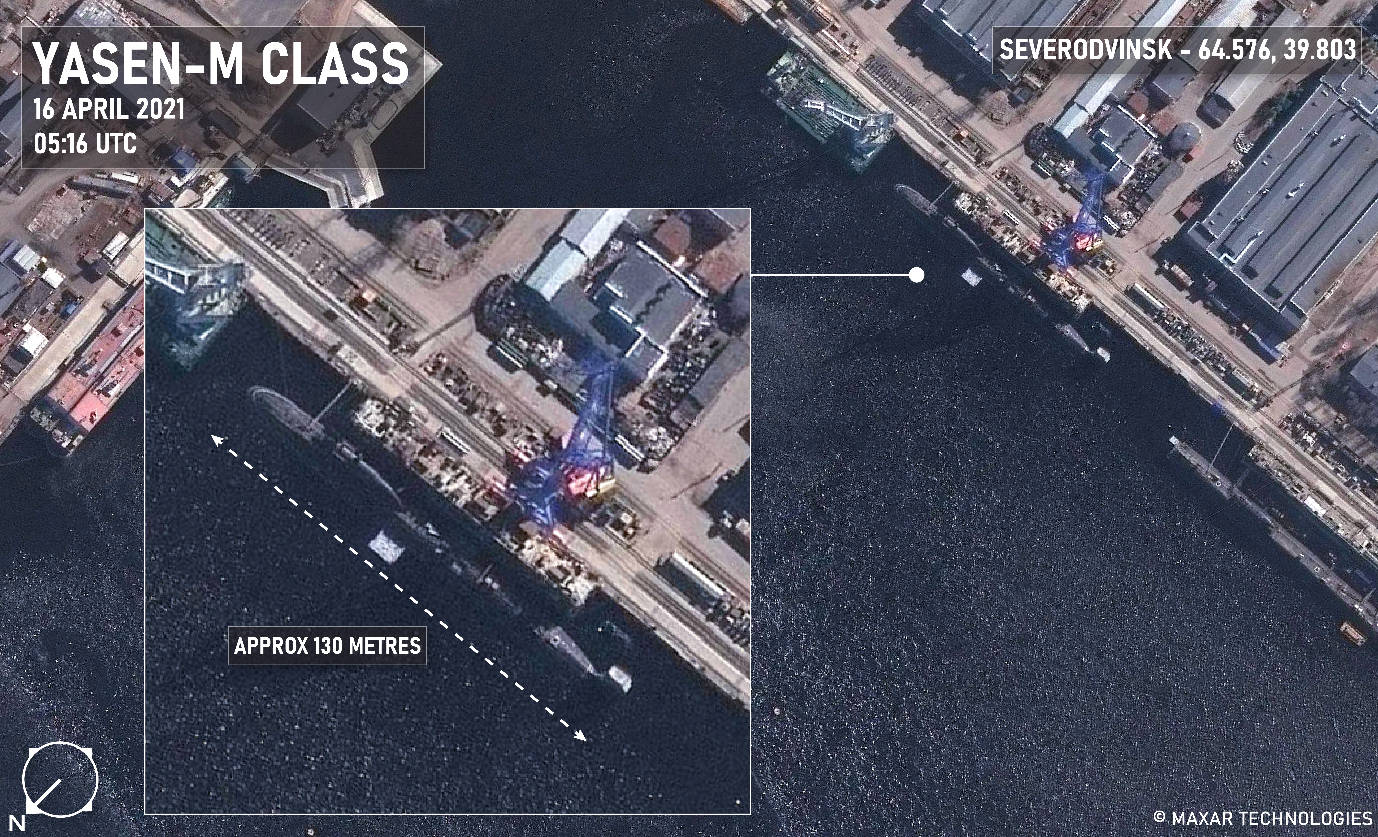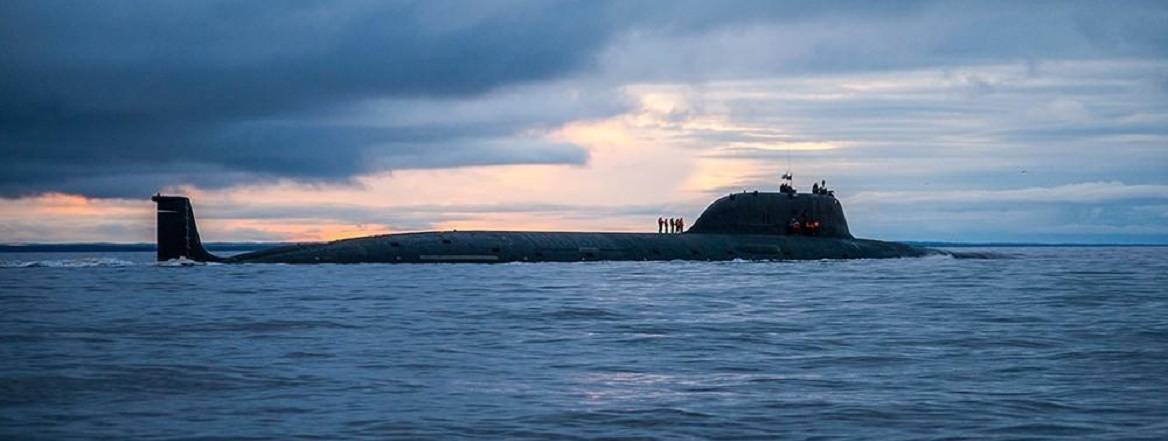The Yasen-M and the Future of Russian Submarine Forces
The recent launch of the Kazan, the second boat of Russia’s Yasen class of nuclear submarines, provides a number of insights into the future of Russia’s submarine fleet.
The Russian Yasen-M-class nuclear cruise missile submarine (SSGN) Kazan was constructed to a shorter build time than the lead boat Severodvinsk. It also appears to be shorter in length than its predecessor by about nine metres. Nonetheless, the two boats share a number of characteristics, including a reported level of quietness comparable to the very best Western SSNs and a long-range strike capability which exceeds that seen on most Western assets.
The Kazan was constructed in eight years, less than half the time taken to construct the Severodvinsk. The slow pace of the latter project was in large part due to the financial troubles which beset Russia in the immediate post-Soviet era. However, the design of the Kazan also evinces a number of evolutionary steps that should allow Russia to cut unit construction costs and build times for future vessels in the class. As such, we might expect future submarines in this class to enter the fleet at a more rapid pace than previously envisioned.
From a planning standpoint, the most notable feature of the Kazan – one which it shares with the Severodvinsk – is its capacity to launch a range of anti-ship and land attack missiles, including the hypersonic 3M22 Zircon. The shift from SSNs like the Akula, which are primarily optimised for a hunter-killer role, towards a concept closer to nuclear guided missile submarines (SSGNs), is likely indicative of a shift in the way that Russian submarines will contribute to future campaigns. Long-range strike missions appear to be superseding sea lines of communication (SLOC) interdiction as a primary task. This will likely necessitate a change in how NATO manages the anti-submarine warfare (ASW) challenge in the High North, given that a strategy of barrier defence at the GIUK (Greenland–Iceland–UK) gap may actually do little to impact Russian submarines, which may have little need to traverse this barrier in order to achieve their operational ends.
Smaller but No Less Capable
The Yasen-M is about nine metres shorter than its predecessor. Part of the reason for this is a reported four-metre reduction in berthing spaces on the vessel. This is consistent with the Kazan having a smaller crew than the Severodvinsk. Imagery analysis of the boat conducted by the authors and other analysts suggests that the primary differences between the two submarines are in the bow-to-sail and sail-to-missile compartment. The sail length of the Yasen-M actually exceeds that of the Yasen by a small margin.

In addition to a reduction in berthing spaces between the sail and missile compartment, two other design features have likely driven the size reduction. First, the incorporation of a fourth-generation KTP-6 monoblock reactor which does not have separate steam generators likely accounts for a 1.6-metre length difference between the missile compartment and the stern. The Severodvinsk used an older OK-650 series reactor. In addition to compactness, the new-generation reactor will also contribute to the quieting of the submarine, meaning that the Kazan may surpass the Severodvinsk in terms of its ability to evade detection.
The second major difference is the length between the bow and sail. The difference in size here is likely accounted for by the fact that the Kazan fields a conformal array sonar, as opposed to the spherical MGK-600 Irtysh sonar suite on the Severodvinsk. The Kazan appears to be equipped with a conformal array comparable to that of the Lira sonar suite aboard the new Lada-class diesel-electric attack submarine (SSK). This system represents a significant improvement on preceding designs; it allows a larger surface area for hydrophone arrays, and thus greater array gains in passive mode compared to the older spherical array sonar configuration. The move towards conformal array sonar mimics the design principles being adopted by Western navies such as the Royal Navy and the US Navy. Moreover, the conformal array shares the spherical array’s wide field of view, and thus represents a comparable improvement over the cylindrical array sonar typically found on Russian submarines. The design of the Kazan has likely eliminated the flank array sonar found behind the bow of the Severodvinsk, but the effects of this may well be offset by the advantages of a conformal array.
Like the other vessel in the class, the Kazan is equipped with the UKSK (3P-14B) vertical launch system comprised of 8SM-346 modules. These cells, with a length of 10 metres and a diameter of two metres, can hold either five 3M54-1 Kalibr missiles or four P-800 Oniks anti-ship missiles each. The system will also be able to launch the 4500km Kalibr-M missile which is reportedly in development, as well as, reportedly, a submarine launched variant of the KH-101. These missiles provide the Yasen and Yasen-M with significant land attack and anti-ship capabilities at long range.
Perhaps most importantly, the hypersonic 3M22 Zircon ASCM will be incorporated aboard the Yasen. With a reported speed of Mach 6–8, depending on its flight trajectory, the Zircon has the potential to overwhelm shipboard air defences by denying them the time they need to develop a firing solution. This will be particularly challenging if, like the Russo-Indian Brahmos missile, the Zircon can perform high-g terminal phase manoeuvres before impact.
In addition, the Yasen and Yasen-M carry ten heavyweight 533mm torpedo tubes, which can also be used to launch the UGST-M wire-guided torpedo, as well as cruise missiles. The submarines also carry six 324mm torpedo launchers as part of their countermeasures system. These lightweight torpedoes, comparable to the barrier system found on the Akula, act as decoys to divert incoming torpedoes.

Implications for the Future Russian Subsurface Threat
In principle, the Yasen and Yasen-M pose a substantial risk to Western forces. The combination of quietness and long-range strike capabilities poses a novel challenge to Western defenders both at sea and on land.
The range at which the two submarines can strike targets on land means that they would not need to run the gauntlet of the GIUK gap in order to disrupt the effective mobilisation of Western forces in wartime. From the Norwegian Sea, these submarines could multiply the vectors from which sensitive targets such as key ports, airfields or command nodes could be struck. This poses a real challenge to Western assumptions that the key challenge for ASW against Russian submarines is to stop them at the GIUK gap to protect Atlantic SLOCs. The emphasis on long-range strike is evinced by the Yasen as well as the incoming Lada SSK and recent conversions of Akula-class SSNs to enable them to launch cruise missiles. This suggests that the hunter-killer mission along SLOCs does not have the priority that it did during the Soviet era. Russian naval planners recognise opportunities to disrupt NATO force posture without breaking into the North Atlantic. This raises a critical challenge for NATO planners: how to neutralise the Yasen and Yasen-M at forward positions such as the Bear Island–Norway gap, which will likely be denied to air and surface ASW assets by Russia’s dense sea denial and air defence networks near its High North bastions?
Moreover, the incoming vessels pose a significant challenge to NATO surface vessels manning positions such as the GIUK gap. They could open the way for other assets like the Akula to break into the Atlantic by eliminating surface vessels manning the gap from long distances. The Yasen and Yasen-M appear to be equipped with satellite communications, with the former carrying the KORA Satcom system and the latter equipped with the Banknot-M system. It would seem, then, that the Russian approach to cueing them against moving vessels is likely analogous to Soviet plans for using the Oscar class in a similar capacity. Within this rubric, Russia’s Legenda and Tselina ELINT and radar satellites would provide the rough locations of vessels to the Oscar class. The latter would then fire a salvo of P-700 missiles, with some of the missiles flying at high altitude to act as spotters for the remainder, which would follow safer low-altitude trajectories. Given the imprecision of ELINT data, this method requires a large number of missiles to be fired to ensure that the area in which a target might be located can be swept by the spotter missiles’ active seekers.
Today, Russia’s ELINT constellation, as well as its other methods of detection such as maritime patrol aircraft (MPAs), are limited. The Liana constellation – intended as a replacement for the Soviet-era system – is still incomplete, and Russia’s fleet of IL-38 and TU-142 MPAs is smaller in size than its Soviet predecessor and will potentially be split between other duties such as ASW in wartime. As such, despite its substantial suite of capabilities, the Yasen lacks the system of systems to ensure accurate cueing. That being said, it should be expected that the vessel will receive at least intermittent engagement opportunities and, should it complete the kill chain, it could inflict crippling damage on a naval formation – raising the risks of operating near Russian anti-access bubbles.
Towards a Smaller but More Versatile Subsurface Threat
As the first Yasen-M-class SSN, the Kazan is a significant bellweather of the future Russian subsurface threat. It entered service far more quickly than its predecessor and demonstrates Russia’s ability to cut building costs without compromising on quality. The pace at which the project was completed would suggest that future vessels in the class should be expected to enter service at a steady pace, avoiding the overruns that plagued the Severodvinsk project.
The vessel itself, moreover, is indicative of a shift in Russian planning. In addition to representing a qualitative leap in terms of its relative quietness and sensor suite, the Yasen-M is indicative of a shift from pure SSNs like the Akula towards SSGNs. This is eminently reasonable within the context of Russia’s planning assumptions for a limited conflict on its borders, in which the ability to inflict calibrated ‘assigned damage’ and to disrupt key adversary nodes within Europe is of greater importance than SLOC interdiction in the Atlantic. After all, if short war assumptions prove accurate, then substantial US reinforcements should not materialise at the speed of relevance in any case. While it was reasonable for the USSR to prioritise SLOC interdiction operations against the flow of US forces across the Atlantic in the context of a full-scale war in Europe, such operations are of less salience within the ‘local war’ rubric of current Russian planning.
Instead, per current Russian thinking, it is the disruption of the response options of NATO forces within Europe which will be key. This can be accomplished by striking key ports, airfields and command nodes, as well as the strategic use of limited countervalue strikes to slow down NATO decision-making by raising the perceived risks of wider conflict. Notably, none of these missions necessitate breaking through the GIUK gap and can be accomplished by the Yasen and Yasen-M from relatively safe positions in the High North.
Western maritime planners will need to shift their focus from fighting a fourth Battle of the Atlantic to neutralising an increasingly capable and versatile Russian submarine threat from forward positions.
Sidharth Kaushal is Maritime Research Fellow in the Military Sciences team at RUSI.
James Byrne is a Senior Research Fellow in the Proliferation and Nuclear Policy Team RUSI
Joseph Byrne is a Research Analyst in the Proliferation and Nuclear Policy Team at RUSI
Gary Somerville is a Research Analyst in the Proliferation and Nuclear Policy Team at RUSI
WRITTEN BY
Dr Sidharth Kaushal
Senior Research Fellow, Sea Power
Military Sciences
James Byrne
RUSI Senior Associate Fellow, Military Sciences
Joe Byrne
Former RUSI Research Fellow
Gary Somerville
Former RUSI Research Fellow


